How buckwheat blooms: description, its benefits and application
The plant got its name "buckwheat" because it was brought to Russia from Greece. And his grain was called "Greek grain." The valuable bread and melliferous culture has gained popularity thanks to its tasty and nutritious cereals.
The plant does not need special growing conditions. On poor soils, good nutrition is provided due to the powerful root. Below you will find a description of the plant and find out why buckwheat flowers and leaves are valued, how it looks in the photo and where it grows, when it blooms and at what time it is harvested, as well as its benefits and uses.
The content of the article
Botanical description and characteristics of buckwheat
Tall and branched plant with a well-developed root system - this is how buckwheat can be characterized. The height of the stem reaches 1 m. The root has the form of a rod, the root system consists of three tiers and is able to go deep into the soil.
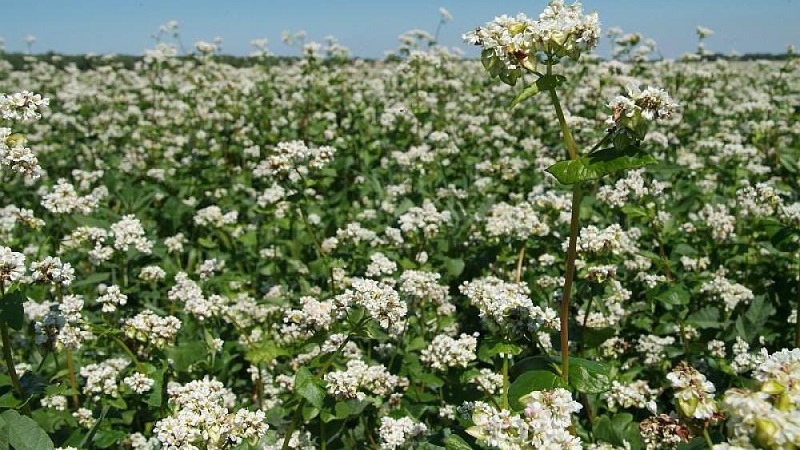
What it looks like and where it grows
The stem of buckwheat is green, but at the time of seed ripening it acquires a bright red hue.
Green foliage is triangular... The upper leaves are directly on the stem, while the lower ones are attached with petioles.
Buckwheat has fruits of a brown hue, outwardly resembling nuts with sharp edges and a film shell.
Places where buckwheat is grown are located closer to foreststhat protect the fields from the winds. Near the forest, the soil is light and has air access. After warm weather is established, buckwheat is planted. The culture is grown more in the southern part of Russia. There the crop is harvested twice a season. Buckwheat grows well in the Far East and Transbaikalia. These places have high humidity and fertile soil. The culture does not grow in the wild.
It is preferable to sow seeds in soil that contains nutrients... Excessive acidity and high alkalinity are unacceptable in the soil. The culture grows well in fields where winter crops, beans and peas were previously grown.
Buckwheat is the only crop in agriculture that is not afraid of weeds... Where it is sown, weeds do not grow at all. The plant completely displaces and suppresses them. The person is automatically freed from weeding.

How buckwheat grows and blooms
When the soil warms up to + 8 ° C, the seeds are sown... The first shoots appear when the air temperature is not lower than + 15 ° C. Flowering begins around the twentieth day, provided that the air warms up to + 25 ° C, around June. It is difficult to more accurately determine the beginning of flowering.
The blooming buckwheat field is amazingly beautiful. It looks like a light pink blanket over which bees are buzzing and circling. Anyone who once watched the flowering of buckwheat leaves this picture in his memory for a long time.
What flowers look like, what color
The culture begins to bloom in mid-June and continues all summer... The plant has small flowers that are collected in inflorescences. On them there are female and male flowers in the amount of 700 to 1500 pieces. Each flower has five petals in different shades from white to pink. The seed is not formed from every flower.
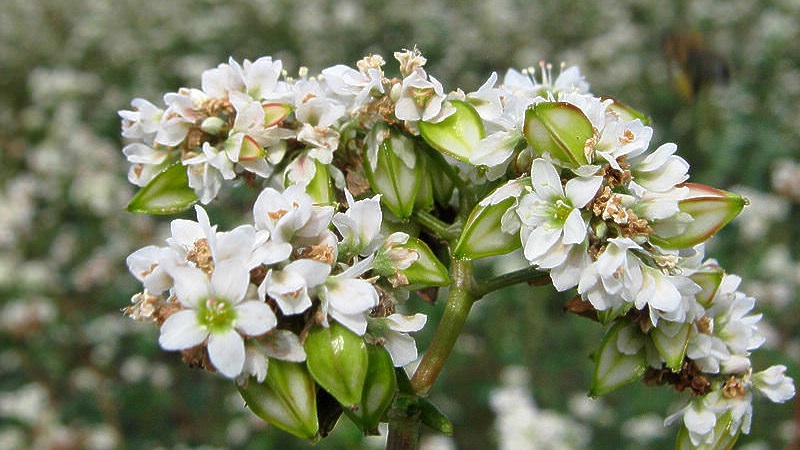
Detailed flowering description
During the flowering period, thousands of bees fly to the buckwheat field. They are in a hurry to collect nectar, and during this period it is better not to approach the field.
Buckwheat begins to bloom from the bottom up along the main stem... Each flower only blooms for one day. Re-opening can only be in cloudy weather, but there is no more pollen in the anthers. New flowers bloom every day, giving the impression of a long bloom.
Buckwheat belongs to the remontant annual... On its bush, you can simultaneously find both ripening grains, and only blossoming flowers and even buds.
When the crops are harvested
Harvesting begins at the end of September... First of all, fields are harvested where more than 75% of the grain is ripe.
So that in hot and dry weather the grain falls off less and the stalks do not break, mowing is carried out in the early morning or in the evening, after sunset... At this time, the humidity of the air rises, which favorably affects the harvest.
Modern technology is able to process grain during buckwheat harvesting... The grain is sorted out and sent to the warehouse. Sorting is done there. One part is shipped to consumers, the other goes for sowing.
Unripe buckwheat has green kernels and the taste of hazelnuts... It is harvested raw, then dried well. This increases the shelf life of the grains, but the beneficial properties are partially lost. During industrial processing, the cereal becomes brown - the same color as it is used to see in stores.
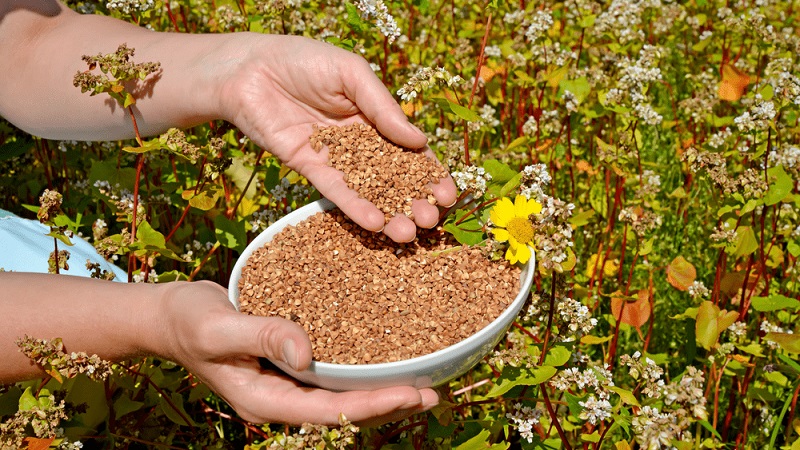
Useful properties of buckwheat
In most regions of Russia buckwheat is the main honey plant.
Why buckwheat flowers and leaves are valued
When the weather is humid and warm, you can observe the abundant secretion of nectar and pollen from flowers.... Buckwheat honey is dark in color with a spicy aroma. It is widely used for skin diseases, atherosclerosis and anemia.
Buckwheat leaves have excellent antiseptic properties... They are applied to abscesses and festering wounds. The inflammatory process passes quickly, the wound heals.
How it is used
By composition buckwheat is a useful herb... Its preparation is made for the production of pharmaceuticals. The most commonly used plant seeds and grass. Flour is produced from buckwheat, which is of great benefit, thanks to which it is used in dietary nutrition.
The content of rutin in buckwheat reduces the fragility of blood vessels and increases capillary permeability. As a result of the use of the plant, blood vessels are noticeably improved.
Reference. The herb has an expectorant effect and removes phlegm.
Thanks to lecithin, buckwheat is recommended for use in diseases of the liver, heart, nervous system.
After eating buckwheat, the carbohydrates in its composition leave a feeling of fullness for a long time.

Buckwheat is rich in vitamins and minerals, which increase metabolism, relieve puffiness, normalize blood flow, have a beneficial effect on vascular spasms. Medicines from this herb help with insomnia.
These are not all the advantages of buckwheat. In this plant even flowers are appreciated, from which delicious and healthy buckwheat tea is brewed... For medicinal purposes, the tops of the plants are dried in a dark place. The main thing is that the sun does not fall on the raw materials.
Pillows filled with buckwheat husk... You can make them yourself or purchase them from a store.
Traditional medicine recipes using buckwheat flowers
Broths and infusions of buckwheat flowers widely used in traditional medicine:
- When coughing, a flower infusion from this plant helps very well. To prepare it, you will need 0.5 liters of water and 1 dessert spoon of buckwheat flowers. They insist for two hours, covering it with a lid. Take half a glass three times a day.
- With arthritis, drink up to four glasses a day chilled infusion of dried flowers, prepared from 1 liter of boiling water and 6 tbsp. l. flowers of buckwheat. The same infusion, only half a glass four times a day, can be drunk under reduced pressure, which is accompanied by a general weakness of the body.
- With panaritium and abscess, it is very effective to make compresses and lotions from infusions. Two tablespoons of a mixture of dried flowers and buckwheat leaves are poured with one glass of boiling water. With the same solution, it is good to rinse ulcers and wounds.
- Fresh whole or chopped leaves are applied to festering wounds and abscesses. The ground buckwheat grains are sieved on a fine sieve and used as baby powder. Buckwheat flour is actively used in cosmetology - they make face and body scrubs. The skin is not only cleansed, but also hydrated and nourished.
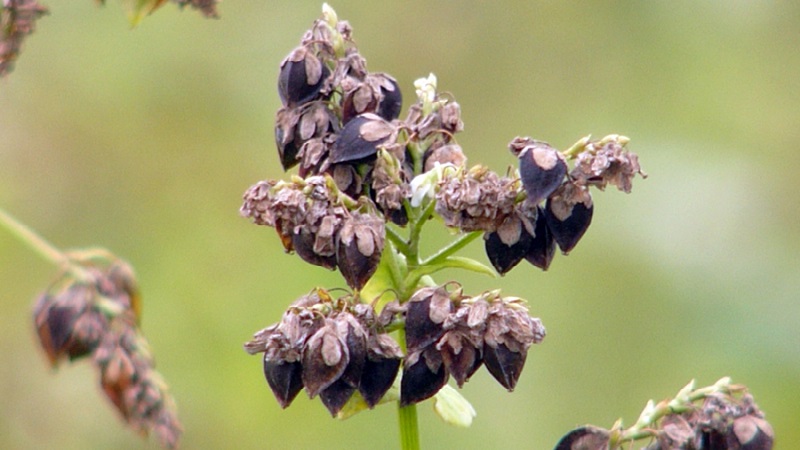
Harm and contraindications
Buckwheat, like any product, can bring not only benefit, but also harm.
Fresh flowers and buckwheat grass are poisonous... They cannot be consumed in large quantities, since they contain toxic substances. They have an antibacterial effect. Fresh herb can be used in unlimited quantities only as an antiseptic or hemostatic agent.
Thorough drying of raw materials is required before use... Buckwheat products are prohibited for use with increased blood clotting.
Buckwheat has no contraindications... It can be used by everyone, but with caution to certain categories of people.
Important! Children are not recommended to give buckwheat in large quantities.
People with kidney failure and diabetics buckwheat should be eaten in limited quantities.
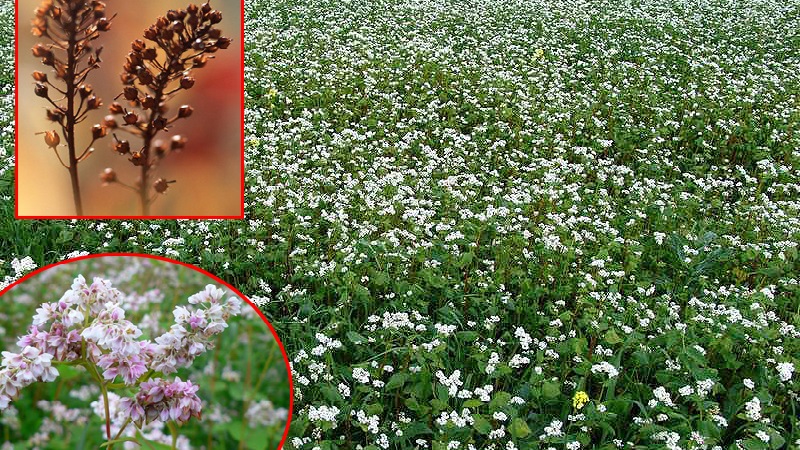
Cool-boiled buckwheat porridge stimulates digestion gas formation and may cause constipation.
Don't get carried away buckwheat diet more than five days... This can harm the body by depleting the diet.
By eating buckwheat, the body receives a lot of energy... Therefore, when taken in large quantities, especially at night, croup can cause insomnia and overexcitement.
If there is a tendency to increased blood clots, eating buckwheat is undesirable.
Conclusion
Buckwheat is ideal for weight loss diets. Buckwheat porridge is considered a national Russian dish. This product is characterized by a high content of proteins, complex carbohydrates, ash substances. Its beneficial properties significantly exceed the potential harm.